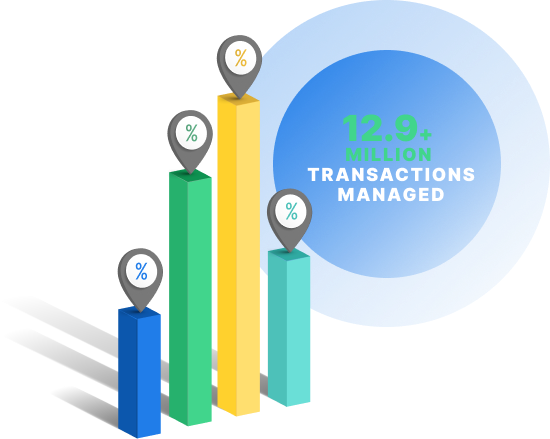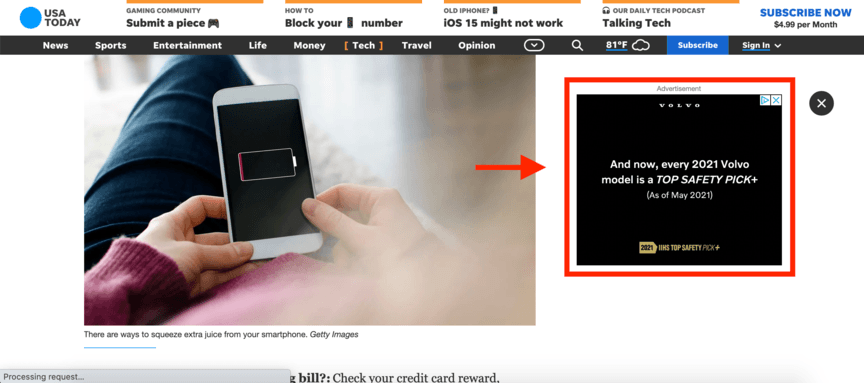Your Introduction to Digital Advertising Technology
Digital advertising technology is the basis of your ad campaigns
Digital advertising technology — also called adtech — is a term used to refer to various programs and platforms involved in paid online advertising. But rather than being a list of tools, adtech is in fact an entire system of interconnected elements.
Anytime you launch a digital advertising campaign, you use digital advertising tech. It facilitates the entire process from ad creation to publication. If you want to better understand that process, you’re in luck — we’ll take a deep look into adtech below.
Read on for more information, and then partner with WebFX’s team of over 500 experts to get help setting up your own advertising campaigns. Just call 888-601-5359 or contact us online today!
Time to Level Up Your Sales
Our long list of services helps you grow every aspect of your business with marketing strategies that are proven to increase bottom-line metrics like revenue and conversions.
In the past 5 years, we’ve managed more than 14.9 MILLION transactions across our client base.

Advertisers and publishers
Ultimately, all the components of online advertising technology exist to support the interaction between the two primary entities — the advertiser and the publisher. Read on to learn what each of these is!
The advertiser
In digital advertising, the advertiser is — as you might guess — the person or business trying to advertise themselves. If you see a paid ad online, the advertiser is the company selling the products or services in the ad.
Assuming you’re here because you’re trying to manage your own paid ad campaigns, that makes you the advertiser. You create the ads and use them to lead users to your site. But to display them, you need to interface with the publisher.
The publisher
The publisher is the entity that provides the space for the advertiser to display their ads. For example, let’s say you see a Volvo ad while you’re browsing an article on USA Today. The publisher in that scenario is USA Today because they’re the ones providing the ad space.

If you want to run a paid ad campaign, you’ll need to work with a publisher of some kind. Google is one of the most common publishers, but you can also use other ad networks to market yourself.
Programmatic ad buying
There was a time when advertisers and publishers negotiated deals by talking with one another directly. With the advent of digital advertising tech, however, that changed. Today, programmatic ad buying is the means by which the two entities interact.
Learn more about programmatic ad buying in this video:
There are two main types of programmatic ad buying — programmatic direct and real-time bidding (RTB). Read on to find out what each of those is!
Programmatic direct
Programmatic direct starts off similar to the old-fashioned way of gaining ad space. The advertiser and publisher interact directly at first to establish a fixed price for the ad space, which takes the form of cost per mille (CPM), or the average cost of 1000 ad impressions.
Once the price is set, the programmatic element comes into play, automatically setting up and running new ads based on the initial agreement.
Real-time bidding (RTB)
Real-time bidding (RTB) is a more automated alternative to programmatic direct and is far more common. With RTB, the advertiser bids on ad inventory through an ad exchange (which we’ll learn more about in a moment).
The ad exchange automatically awards ad space based on the bids, meaning publishers are able to sell their ad space without having to get involved directly. It also means the price varies from publisher to publisher based on how much demand there is for their ad space.
The adtech system
Digital advertising technology is more than a handful of tools. It’s a whole network of entities that interact with each other to drive the advertising process. Some of those entities are platforms or adtech software, while others are companies — but they all play a key role in adtech. The entities we’ll be looking at are:
- Demand-side platforms (DSP)
- Supply-side platforms (SSP)
- Ad exchanges
- Ad networks
- Ad servers
- Advertising agencies
- Advertising trading desks (ATD)
Below, we’ll define some of those entities and how they engage with one another. Here’s an overview of the online advertising tech system!
Demand-side platforms (DSP)
One of the first pieces of online advertising tech to know is the demand-side platform (DSP). DSPs are platforms designed specifically for advertisers. Essentially, DSPs are how advertisers plug into the larger adtech system.
On a DSP, you can set your budget and your ad preferences, such as how frequently those ads appear to users and which types of audiences they target. DSPs then interact with other entities in the adtech ecosystem — which we’ll explore below — to facilitate the ad purchase process.
Supply-side platforms (SSP)
Where a display-side platform is the advertiser’s gateway into the adtech system, a supply-side platform (SSP) is the publisher’s. Just as advertisers use DSPs to interface with other adtech entities and set up their side of the ad process, publishers use SSPs to do the same on their end.
SSPs allow publishers to set up all the details of the ad space they’re selling. They can determine price floors for their inventory, as well as which types of advertisers can buy ad space on their websites.
Ad exchanges
We’ve talked about DSPs on the advertiser’s side and SSPs on the publisher’s side — but where do these two meet? The answer is ad exchanges, which serve as the middle ground between the two parties.
Ad exchanges are platforms that handle the transactions between SSPs and DSPs. They use programmatic ad buying — specifically real-time bidding — to match up publishers and advertisers and sell ad inventory.
Ad exchanges are sometimes integrated directly into SSPs. In that case, the DSP and SSP interface directly, reducing the number of platforms needed to complete the ad inventory purchase process.
Ad networks
Just like ad exchanges, ad networks are a way for advertisers and publishers to conduct transactions over ad inventory. However, ad networks are very different from ad exchanges.
Ad exchanges are digital platforms that sell low-priority inventory automatically. Ad networks, though, are none of those things.
Firstly, ad networks aren’t automated platforms — they’re companies. Secondly, they don’t sell low-priority inventory. On the contrary, ad networks are for publishers’ premium ad space. And thirdly, ad networks typically rely on manual agreements rather than real-time bidding.
Ad networks bundle top-quality ad inventory for publishers, who can then sell it to advertisers. Instead of being set by bids, the price is determined by the publishers.
Ad servers
Unlike all the previous entities on this list, ad servers don’t have any role in the transactional side of adtech. Instead, their job is to deliver the ads themselves, transferring them from the advertiser to the publisher and then displaying them on the publisher’s site.
Ad servers come in two main types: First-party and third-party. The “first party” in this instance is the publisher, meaning first-party servers are the kind the publishers use to set up the ads on their website. The third-party servers, meanwhile, are used to get the ads from the advertiser to the publisher.
Advertising agencies
Advertising agencies are third-party organizations that help advertisers manage the advertising process. Typically, agencies assist with every stage of the journey, from designing the ads to identifying the target audience to helping set the bidding strategy.
If your business is unsure how best to manage your paid advertising, partnering with an agency can be an excellent decision. Agencies are experts at online advertising tech and can provide all the necessary services to help you drive top-tier results.
When you partner with an agency, it’s a good idea to look for a full-service agency — that is, an agency that offers other digital marketing services in addition to advertising. That way you can go to the same place for help with all your marketing.
If you decide to look for an agency, be sure to consider WebFX. We have over 28 years of online marketing experience, and we know digital advertising tech inside and out!
Agency trading desks (ATD)
Agency trading desks (ATDs) are services that some advertising agencies offer. These agencies can help you optimize for many parts of the advertising process, but ATDs specifically focus on programmatic ad buying.
An ATD can help your business manage your DSP and optimize your bidding strategy, getting you the best ad spots for the lowest cost. Not every agency will necessarily use the term “agency trading desk,” but the point is to find an agency that can handle your real-time bidding strategy.
Figuring out the best approach to RTB can be tricky, so putting it in the hands of an agency is an excellent way to improve the results you get from it.
WebFX is a partner businesses trust.
Hear from HydroWorx, who saw a 236% increase in organic sessions with WebFX services.


WebFX can help you master your online advertising technology
Ready to start driving high-quality advertising campaigns through digital advertising technology but need a hand optimizing it? WebFX is one of the top adtech companies in the industry and we’d love to help you out!
With over 1,100 client testimonials, we have everything it takes to boost your advertising.
Our paid advertising services are a great way to improve the quality of your adtech strategy. We can help you do everything from designing your ads to optimizing your bids. We’ll even provide you with a dedicated account representative to keep in touch with you about all that we do.
To get started with us, just give us a call at 888-601-5359 or contact us online today!









